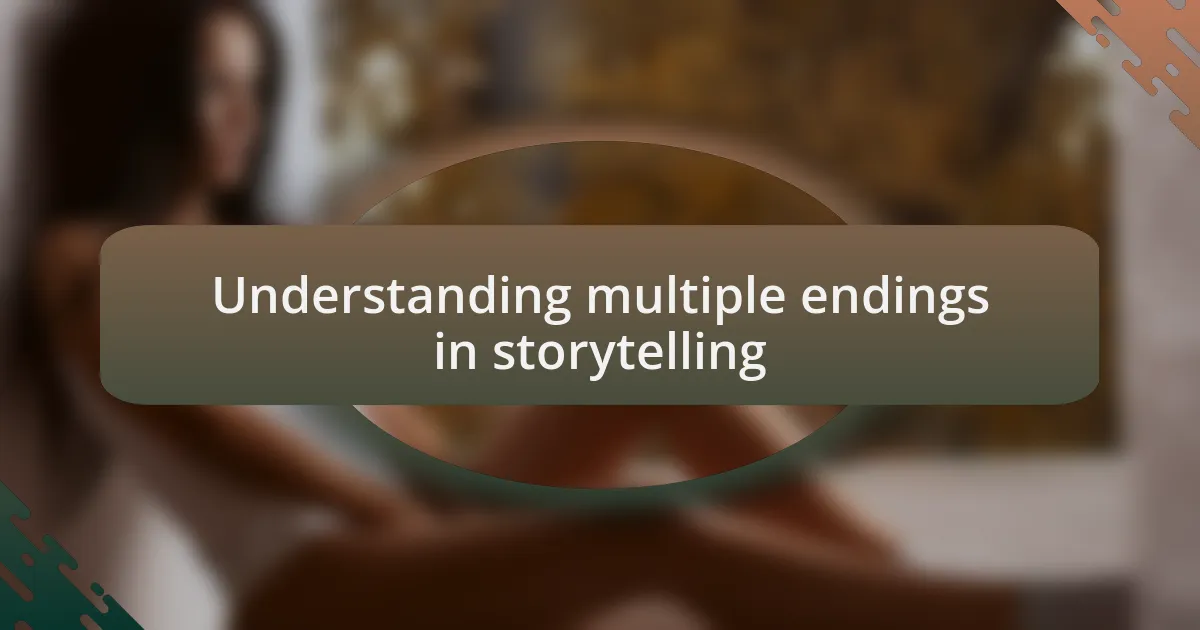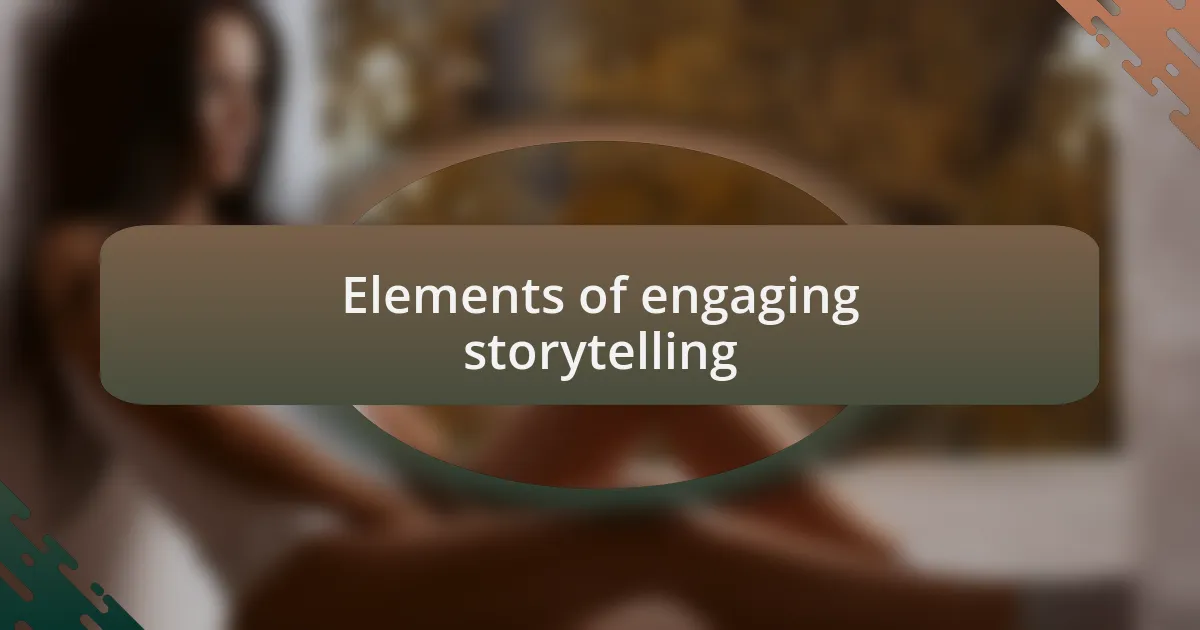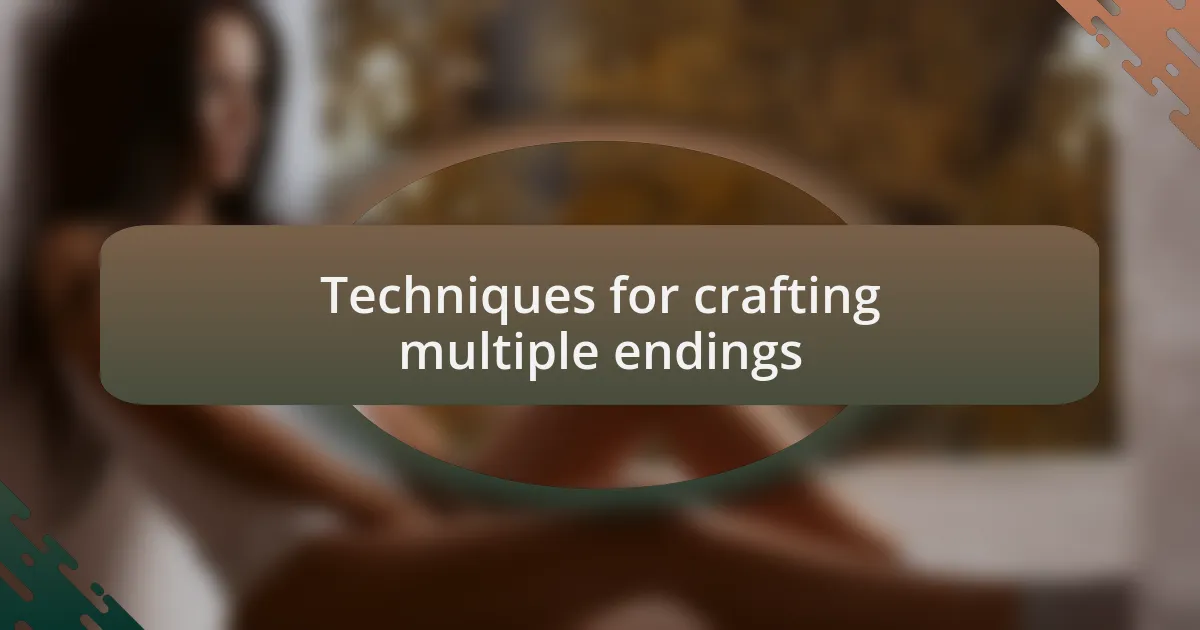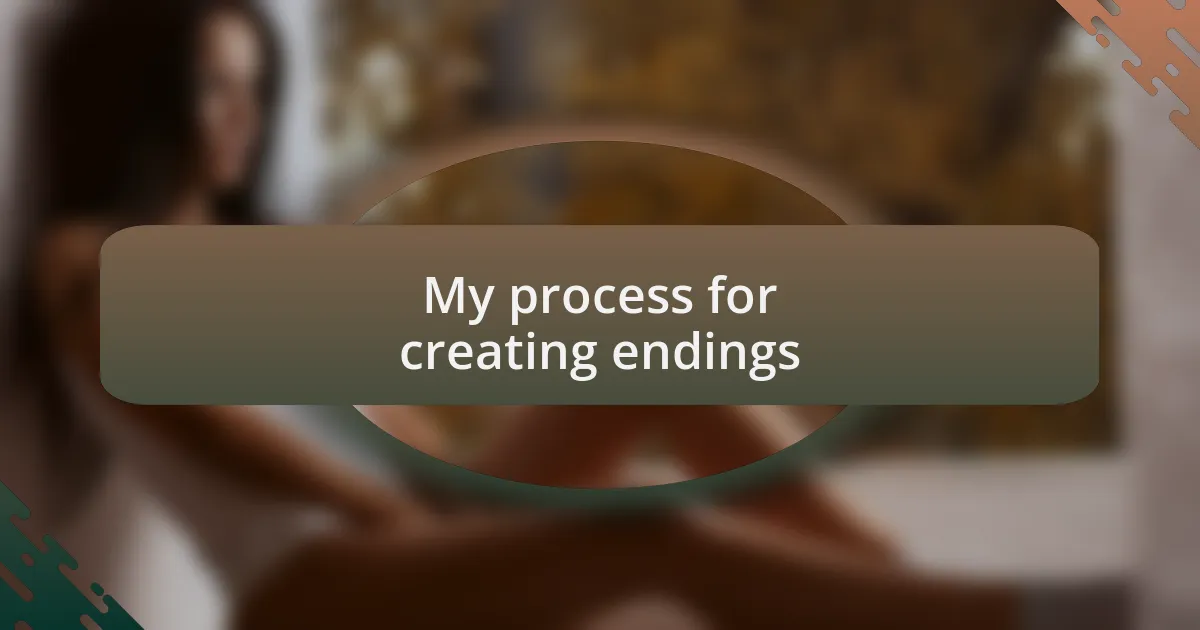Key takeaways:
- Multiple endings in storytelling enhance engagement and encourage young readers to explore emotions and critical thinking about choices.
- Elements such as relatable characters, vivid imagery, and suspenseful structure are essential for creating captivating narratives.
- Techniques like decision points, parallel storytelling, and foreshadowing can stimulate discussions about outcomes and choices in stories.
- Feedback from young readers influences the emotional impact of story endings, highlighting the importance of audience connection in storytelling.

Understanding multiple endings in storytelling
Multiple endings in storytelling can transform a simple narrative into a deeply engaging experience. I remember reading a children’s book where the characters faced a choice at the story’s climax, and depending on the decision, the ending shifted dramatically. This made me wonder how easily a storyline could adapt to different perspectives and what that meant for young readers.
As I crafted different endings, I noticed how each path evoked different emotions in me—some endings left me hopeful, while others felt bittersweet. Isn’t it fascinating how a single story can resonate in multiple ways, reflecting the varied experiences of each reader? By introducing children to these variations, we allow them to explore their feelings and think critically about choices, not only in tales but also in their own lives.
Creating multiple endings also encourages kids to use their imaginations more actively. When I presented a story to a group of children with a choice of conclusions, I could see their eyes widen with excitement. They instantly began discussing their preferred endings and the reasons behind their choices, making the storytelling session not just about passive listening but about active participation.

Elements of engaging storytelling
Engaging storytelling hinges on relatable characters that resonate with young readers. I recall a story I crafted about a timid little mouse exploring a big world. Children embraced the mouse’s fears and triumphs, often seeing themselves in that character. When readers connect on this level, they invest emotionally in the narrative, which enhances their overall experience and makes them more likely to ponder the story’s multiple endings.
Another key element is the use of vivid imagery and descriptive language. I remember crafting scenes filled with colorful paintings of a magical forest, where every detail painted a picture in the minds of young listeners. When children can visualize the world you’re creating, they become part of that universe, and their imaginations can run wild, leading them to consider diverse outcomes in the story. Have you ever noticed how a compelling setting draws kids in, making them eager to see what happens next?
Finally, the structure of a story itself can build suspense and anticipation. I often incorporate cliffhangers that leave children hanging—literally and figuratively. For instance, when I ended a chapter with a character at a crossroads, eager minds buzzed with speculation about what might come next. This not only fuels excitement for the story’s direction but also invites discussions about what might happen if different choices were made, further enriching their storytelling journey.

Techniques for crafting multiple endings
Crafting multiple endings is a stimulating way to engage young readers, and one technique I often use is to weave in decision points where characters face significant choices. I vividly recall a story where a brave rabbit had to choose between seeking adventure or staying safe in the burrow. As I read the story to a group of kids, the ones who preferred adventure cheered for the rabbit to leap into the unknown, while others urged him to stay back. This not only sparked an animated debate but also helped the children envision how different choices could lead to wildly varying outcomes.
Another effective method involves parallel storytelling, where I explore various storylines concurrently. In one instance, I crafted a tale that followed a dragon who either saved a village or wreaked havoc, depending on his interactions with the townsfolk. This dual-path approach intrigued the listeners, who found themselves drawn into the intricacies of each decision. It’s fascinating to see how the same character can elicit different emotions and reactions, prompting kids to analyze their preferences and ponder what makes a “good” ending—what do you think is more fulfilling, a story of redemption or one of chaos?
Finally, I find the use of foreshadowing helps to guide readers toward various possible endings without giving too much away. I vividly remember hinting at specific traits of a character that could lead to either success or failure. After the story, kids would excitedly dissect those hints, trying to piece together a logical path to each ending. This not only fuels their critical thinking skills but also emphasizes the power of choice in storytelling, raising the question of what fate truly awaits the characters at the end of their journey. How do you think foreshadowing changes the way a story unfolds?

My process for creating endings
Creating endings is an art that requires not just imagination, but also a deep understanding of my audience. When I craft endings, I often visualize the emotional reactions I want to evoke. For example, in a story about a lonely fox who finds friendship, I debated whether to let him join a pack or go on a solitary adventure. Each option elicited different feelings, leading me to wonder—how do I want my young readers to feel at the story’s conclusion?
I draw heavily on feedback from the children I read to; their responses refine my choices. I once wrote an ending where a squirrel gathers his courage to help a friend. As I shared the tale, I noticed the kids’ faces light up with hope and excitement. Their smiles made me consider: does an ending that emphasizes bravery resonate more with kids than one that simply ties things up nicely? This connection with my audience helps shape my narrative direction.
In my writing, I often employ endings that reflect growth and self-discovery. I can recall one character who initially feared the dark, but by the end, he learns to embrace it as a part of life. Watching kids react to his transformation was enlightening; they often discussed their own fears. This interactive element not only enriches the storytelling experience but also makes me realize that endings can be powerful tools for personal reflection. How do you think our own fears influence the stories we create?